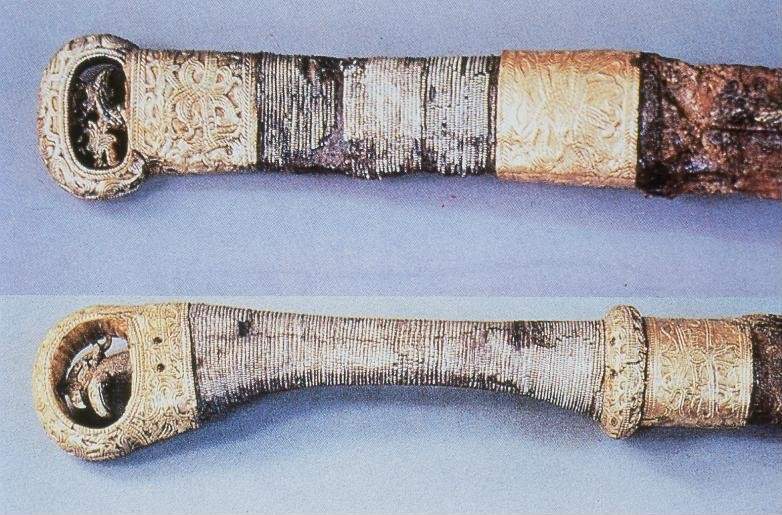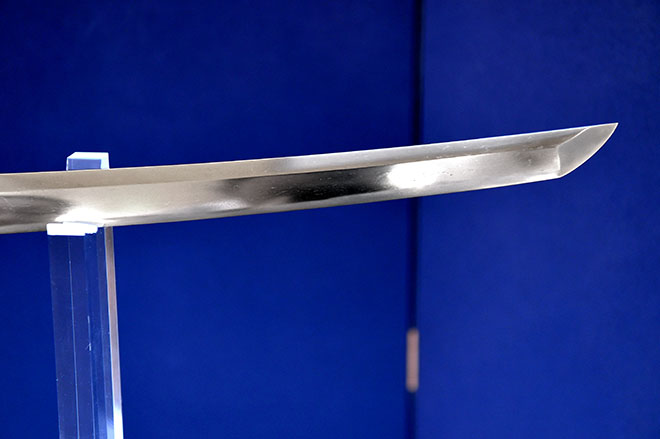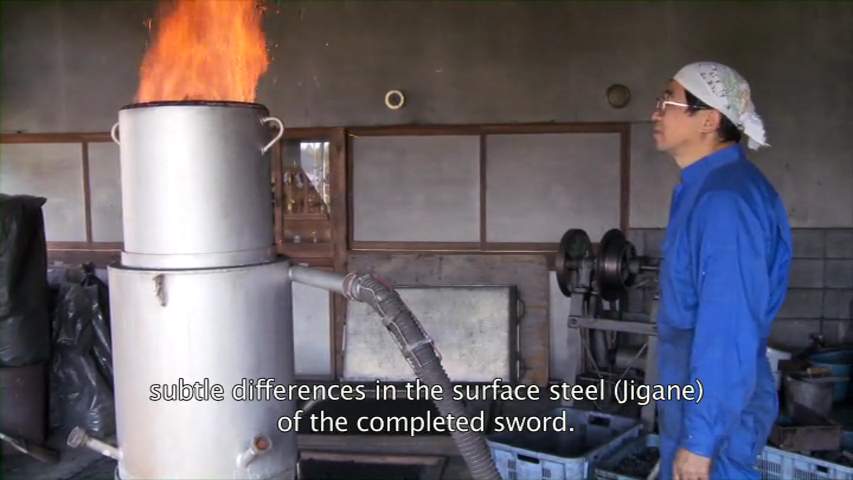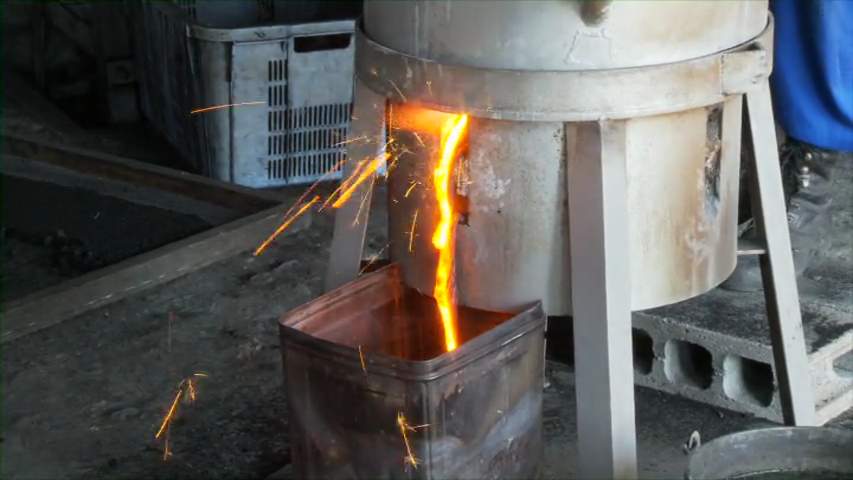[I apologize for not being able to locate the comment that originally led me to this news.] Some ancient Japanese swords were found where they were hidden in 760AD.
NARA – Two swords found under the Great Buddha of Todaiji Temple in the Meiji Era have been identified as sacred swords that had been missing for some 1,250 years since around 760 after Empress Komyo, the wife of Emperor Shomu, who built the Buddha, dedicated them along with other items to the temple, the temple said Monday.
The swords, decorated with gold, silver and lacquer, appear on the top of about 100 swords in the weapon list of the Kokka Chimpo Cho (book of national treasures to Todaiji) kept at the Shosoin repository at the temple. They are considered important historical materials.
The swords were discovered at the end of the Meiji Era (1868-1912) along with other items, including a silver pot near the pedestal on which the Great Buddha sits when three holes were created nearby for research purposes, and were designated together as national treasures in 1930.
Parsing the story of the Japanese swords is a bit difficult. The blades were missing for 1,250 years but were found in the 1900s. They were believed to be the swords, but have only recently identified using X-ray scans:
When researchers at the Gangoji institute for research of cultural property put the swords through an x-ray scan on Sept. 30 as part of preservation and repair work, inscriptions, hidden from the naked eye by rust, were found near the handles of the swords. The inscriptions, made by inlaying another metal into the metal of the sword, read “Yohoken” (treasure sword of light) and “Inhoken” (treasure sword of shadow). These two names come at the top of a record of 100 swords donated by Empress Komyo (701-760) to the large Buddha at Todaiji Temple. The lengths and decorations of the swords almost perfectly match the record.
The Japanese, oddly, are fairly cagy about publishing pictures of swords. I’m not sure why, but it’s difficult to find photos of various great blades. The blades in question were ancient, and well before the advent of the Japanese sword-form we have come to recognize as the “samurai sword” – they looked more like Chinese wushu swords.

I could not find any pictures of the entire sword, and my Google-fu is pretty good.
Being buried is not good for anything made of steel, and forged layered steel decomposes into something that looks a lot like wood. I suppose that you could determine the forging process that was used, based on how it decays.
For example, this viking sword looks almost as though it had blade-facings that were a pattern-forge:

(That tang looks a bit thin – I wonder if it rusted down, or if the sword was a show-sword and most of the handle was wood with that sad little stick of steel through it)

I wonder what the smiths who worked so hard on those blades would think, to see them now? Would they be impressed simply that they have survived so long? Or would they be saddened by the rust?
A wootz (crucible steel) blade would decay differently than a pattern-welded one, which would look like plywood after a few hundred years in the ground. A crucible steel blade would look pockmarked and might have holes through it.
In the ground, a long-buried sword doesn’t look like much:

I’ve been to the viking museum in Oslo (highly recommend!) and one thing you realize pretty quickly: there are a lot of swords in the ground, all over the world. How many have been plowed up, or buried deeper or blown up, as new generations of war-machines cross the landscape?
Sometimes, a rusty old sword turns out to be a masterpiece. I always love these stories, because I like hearing that someone’s hard work was rescued. [asahi]
NARA–One of the oldest Japanese swords in existence has been recognized as a treasure at a shrine here after being found in an attic decades ago.
When the rusty sword was cleaned and sharpened, it was discovered to be from the 12th century, making it one of Japan’s most time-honored weapons, an official of Kasuga Taisha shrine announced Jan. 22.
The discovery means it is a museum piece that will be carefully studied to shed further light on the history of the Japanese sword.
It appears that the “heirloom,” which was made in the Heian Period (794-1185) for a samurai and initially passed down through his family, was presented to the shrine sometime from the Nanboku-cho Period (1336-1392) to the 14th or 15th century, or the early Muromachi Period (1338-1573).
That is one hell of a thing to find in your ‘attic.’

Those priests and shrines – they sure are experts at grabbing and stashing away the prime loot.

I am not sure why they posed the sword with the young woman, who appears to be tiny because of where the camera is focused and the length of the lens that was used.
12th century. It sure cleaned up nicely.

I once talked with a professional Japanese sword appraiser, who told me something interesting about Japanese arms and armor: “The Japanese make more antique arms and armor today, than they ever did during the warring states period.” That’s probably not true, but it’s a good way of putting it. We should be fairly skeptical of mystical valuable swords that just crop up one day, being handed out by strange women lying in ponds.
By the way, I always wanted to do a variant of Excalibur in which Arthur, who is a bit of a nerd and an engineer, finds a sword sticking out of a stone and removes it, sprays it down with WD-40, puts it back, and walks off.
Yes, I know, WD-40 isn’t the right thing. But I’m pretty sure their product placement department would pay out the nose for a plug like that.
I guess that telling people where you’re hiding something kind of defeats the point of hiding it. But, seriously, history is full of stories of important things that were hidden and lost. It seems there needs to be a repository for long-lost secrets, somehow. Besides: treasure maps!

That’s pretty cool, and that last sword is just beautiful.
Somewhere, long ago, I got a thing that is supposed to be a copy of an antique Japanese sword “thingy”. As far as I can determine, it’s called a “menuki” and apparently they normally come in pairs. The copy I have was cast in pot metal and then plated in gold, and made to hang on a chain. Supposedly, the original is in the Smithsonian. The work is fantastic, very detailed and beautiful. I have no idea what a “menuki” is (it does not immediately strike me as something you would find on a sword), but this thing looks pretty damn cool.
The Japanese do some amazing work, and apparently always have.
The title struck a chord with me.
Having previously had a computer stolen while I was traveling, I recently hid my back-up lap top before I went away.
Not having used it for some time after my return, I had no idea where I had hidden it. After prolonged searching, I was about to give up on it, when I found it while clearing out the garage.
Not such a prolonged absence, but nice to find.
kestrel #1
You are correct. A menuki (めぬき)(目貫) is a sword thingy.
They are a decoration on the hilt that also serve a practical function.
The function escapes me be cause the specialized vocabulary of “Samurai” swords makes my head hurt.
@Marcus
Four dimensional swords?
chigau and kestrel:
The menuki serve to texture the shape of the handle (tsuka) to improve the grip – basically they are left/right registration-marks. Japanese swordsmanship greatly depends on knowing the blade angle perfectly at all times and since the edges of Japanese blades are very hard, they can chip if they cut off-angle. Once you have some practice with the feel of a katana, it drops right into your hand and is amazingly precise. The practical reason for the menuki is subtle but significant – you can orient the blade with your eyes closed.
I believe I mentioned this elsewhere but I’ll repeat it because it’s cool: the level of detail in Japanese metal-craft (lacquerware, engraving, sword guards and fittings) and ceramics jumped dramatically when the Portugese began trading with them. The Portugese sold them magnifying glasses!
Marcus
I kinda think they were like those little bumps on the keyboard so you know where your fingers should be.
.
Is that what a ‘registration-mark’ is?
Lofty #4
I saw that, but only on my second reading.
First time through I just read it as “sword sticking out of a stone“.
Because stone is what I was expecting.
*tsk*
No wonder They™ can fool us. We are easy to fool.
chigau@#6:
Yes.
Once I got an interesting lecture once from a roboticist who designed the carrying/filling/labeling machines for a major distillery. Take a look at bottles and packaging and you will often notice little dimples or bumps in the glass – deliberate ones. Those are registration marks – a robot (or mechanical probe) can “learn” the orientation of a bottle, to make sure the label goes on in the right place, by “feeling” for the dimple with a probe. Now that computation is cheap enough to do real-time optical analysis a lot of robots now “look” to see how an item is oriented, check liquid levels visually (instead of dipping a probe in and checking for a change in resistance) etc.
The registration marks on a keyboard are for touch typists who learned to hover their index fingers over the ‘j’ and ‘f’ keys – you can orient on the keyboard without looking down. Very nice. Of course old old school typists simply know where their typewriter is with their eyes closed. (It’s why I use a trackball: the mouse never moves on the desk so I can always find it without looking)
Would that be comment #14 by cvoinescu on your April 11 post “Heavy Metal”?
Lofty@#4:
I corrected it but you caught me before I was able to hit “update.”
Blogging has made me wonder if I am suffering brain damage or something because I make many more mistakes than I think I ever used to. But it could have something to do with my output being 20-30 times what it used to be. Assuming a flat error distribution, I make a lot more mistakes through volume (not by weight).
Marcus #9
Sit down, Dear. Have a cup of tea.
.
Yes. You are aging. Take notes, leave notes.
You will be fine. You are so meticulous that when They™ find the pile of ash, there will also be an explanitory note.
Marcus, those are the very swords I was talking about — the ones at the Tōdai-ji temple.
We were running very late and almost missed the museum (feeding the bowing deer in the park was a great hit with the kids — they’d played at being deer and bowing for food for days afterwards). The swords were in the first room. There was a “no photography” sign, and the attendant watched me the entire time, so I could not take any photos.
“Warranty void due to improper storage. Perhaps you would like to purchase a replacement?” Even a master craftsman has to be a businessman some of the time.
That might make a nice twist for a heroic quest / fantasy story about finding the lost something-or-other. After fourty years of fruitless searching only a few bits and pieces turn up, some of them marked by what might have been tank treads. The quest fails, the Magical Cycle Of Whosit is not completed and the world ends.
Arthur the Landscaper would haul the stone and sword off to sell it to some rich guy for their lawn.
—
Matroshka swords! (A great way for the blacksmith apprentice to challenge themselves *nudge*)
The first article dates to 2010, and the location is the temple of the Great Buddha of Nara.
The second article is from January 2018, and the location is a Shinto shrine also in Nara, just a few blocks away.
The young woman may look small, but her fingers look very long.
Usually when valuable artefacts are hidden and then not recovered, it’s not because the person who hid them forgot where they hid them, but because the person who hid them didn’t survive whatever circumstances prompted them to hide them in the first place.
@chigau and Marcus: Thank you! That makes a lot of sense: I never thought of them lying along the handle to guide the grip of the hand. Also, thanks to the Portuguese! The level of detail in this menuki is so incredible I would guess it was made AFTER they had magnification for working on it! Wow, a mystery solved after all these years.
cvoinescu@#2:
Marcus, those are the very swords I was talking about — the ones at the Tōdai-ji temple.
Ah, yes.
(I searched on them based on your comment; there are a lot of ancient heirloom Japanese swords apparently popping out of the ground and falling out of the attics of temples everywhere. I suppose if someone were to shake down all the cathedrals of Europe there would be some pretty amazing loot, too – and that’s without counting the vatican loot-pile, which is pretty incredible.
We were running very late and almost missed the museum (feeding the bowing deer in the park was a great hit with the kids — they’d played at being deer and bowing for food for days afterwards). The swords were in the first room. There was a “no photography” sign, and the attendant watched me the entire time, so I could not take any photos.
You were very lucky. They don’t bring the famous swords out very often, and they seldom put them in one place. There was an exhibit a decade ago that people flew in from all over the world to see. I’d have probably sucked it up and gone myself except I didn’t hear about it until a year after it was too late. I believe the pictured 12th century sword was displayed at that show and the picture above may have been taken at that show.
I also wonder if that picture was done with a hidden/secret camera. That would explain the extreme lens-distortion (one of those button-lens spy cameras) – that’s why the girl’s hand looks so huge and the rest of her is so tiny. The sword probably doesn’t look quite like that, either.
Whoever polished that thing was probably Japan’s best sword-polisher at the time. And it shows. Doing a polish like that, on a sword like that, is the culmination of a life’s work. At the big exhibit a decade ago, there were dozens of great blades on display. There are a few photos that look like they were sneak shots.
I suspect there is a certain amount of “we don’t want people to see the condition of the sword itself because some dipstick buried it in a damp place for a very long time” in why they aren’t displaying them. There is also some sword-worship. Naturally, religion gets all over everything and screws it up; they’re “holy objects” and such bullshit.
Thank you for posting about the blade!
As far as I recall the vast majority of “viking” swords were actually made in the Frankish kingdoms and exported to the Nordic regions. Which is why the vast majority of the inscribed ones use the Latin alphabet, and often the Latin language, rather than runes and Old Norse. So I imagine the Carolingian swordsmiths weren’t all that fussed what their northern customers did with their purchases, as long as they paid on time and kept coming back for more.
As far as the role of the sword in early medieval European culture goes more generally, there are plenty of stories about famous magical swords (Caladbolg, Hrunting, Durandal, Excalibur), but they tend to get their renown more through who wields them and the famous deeds they have accomplished than some quality of their manufacture. Even when it is the physical components of the sword that are singled out for their importance, it tends to be that the sword was made with holy relics (Roland’s sword Durandal was supposed to contain half a dozen bits of saint embedded in its hilt), rather than just being well forged. One suspects that the medieval Christian thinking about the rusted remains of centuries-old swords would conclude that the decay and corruption is a sign that the sword wasn’t particularly important to begin with – important relics get divine protection from the processes of earthly corruption.
Introducing: “The Sword of Heaven,” a katana forged from a four-billion-year old meteor.
Reginald Selkirk@#19:
Introducing: “The Sword of Heaven,” a katana forged from a four-billion-year old meteor.
Damn.
Meteoric iron is actually not very good material although it can be insanely tough. Alec Steele did a bit where he tried to forge a meteorite into something and it wasn’t very impressive. Where meteoric iron can get interesting is where you use it in crucible steel and you wind up with, well, mystery metal. Mystery metal is like rolling the dice: sometimes you roll a ’00’
A smith like Yoshindo Yoshihara does his own metal refining and is deeply knowledgeable about the composition of the metals he is working with. I’d bet a dollar to a donut that they analyzed the meteorite and it went into the crucible (tatara in Japanese)
There is a super cool movie The Art of The Japanese Sword which has some amazing footage of some of these processes, including a smith using a modern tatara – he kind of uncorks a valve at the bottom and hot gooey steel flows out. Yow. Highly recommended: [wc] [let me again thank ahcuah for suggesting I link to WorldCat! Brilliant!]
Vertical tatara:

Looks like it’d be good on your pancakes:

cartomancer@#18:
So I imagine the Carolingian swordsmiths weren’t all that fussed what their northern customers did with their purchases, as long as they paid on time and kept coming back for more.
Perhaps that explains the narrowness of the tang on that one sword. “Export model.”
Roland’s sword Durandal was supposed to contain half a dozen bits of saint embedded in its hilt
That’s probably why he died: blade delaminated in the heat of the fight; too much saint-ash in the welds. (I know you said “hilt” but my brain went there)
The meteoric iron sword is cool, but I’m not necessarily awed by the age of the iron. Pretty much all iron on Earth is older than the Solar System, because it was already there when it formed. An old lump of metallic iron fell to Earth and some of it survived the entry into the atmosphere and did not burn up. Meh.
I’m a little more impressed by the iron that came from space four and a half billion years ago, spent a billion years dissolved in the primordial ocean, then precipitated as iron oxides over the course of one and a half billion years (thanks to those pesky cyanobacteria making oxygen, using nuclear fusion energy), then the tectonic plates moved and some of that sediment became land, and we found it and mined it and reduced the iron with coal (dead pants, 300 millions of years old) and limestone (dead sea creatures, some 100 million years old), and made it into swords.
Regarding the exhibit at the museum next to the temple, I think the two swords might be permanently on display. The museum is quite small. It’s the rest of the treasure trove from the temple that gets a few dozen items exhibited for a couple of weeks each year (at a different museum, the Nara National Museum). That exhibit was not on when we were there.
Re: Marcus Ranum (#17):
Sorry, but what lens distortion? Whenever I suspect distortion I like to look at the straight lines in the image to see if they’re really straight. In this instance they are, e.g. the table edge and the horizontal and vertical lines on the wall in the background.* Even if the image had been cropped to make it less obvious, those lines would still be a giveaway. My theory is that the sword is unreasonably big and the woman blessed with piano-playing hands, lucky her.
Besides, isn’t an archive like Getty Images be supposed to be above sneaking in and / or stealing images? While the powers that be may be reluctant to allow photography they probably realised that it would be completely unreasonable (not to mention impossible) to avoid it altogether.
*I even checked with a ruler because I have no reason to trust my fallible optical system, let alone the shoddy processor it connects to.
A googleimage search for “asahi shimbun kohoki sword” shows several different photos of the same sword and the same woman.
komarow @#23
You are currently talking about deviation from rectilinear projection; basically, the phenomenon that the camera lens makes straight lines appear not straight. There can be barrel distortion (for wide angle lenses), pincushion distortion (in telephoto lens), mustache distortion (this one is rarer).
Marcus was talking about a completely different phenomenon: the perspective distortion. That’s the warping of an object and its surrounding area that differs significantly from what the object would look like with a normal focal length, due to the relative scale of nearby and distant features. For more see: https://en.wikipedia.org/wiki/Perspective_distortion_(photography)
Anyway, the thing Marcus meant was that this photo is obviously shot with a wide angle lens. With such lenses, objects closer to the camera look very large, objects further from the camera look very small. Notice that this lady’s left hand (which is closer to the camera) looks larger than her right hand (which is further from the camera). Since the sword is closer to the camera and the lady is further away, the sword looks larger than it is and the lady looks smaller.
Would someone please tell me where I hid two of my stethoscopes?
Raucous Indignation #26
One is under the bed, the other is in that old backpack in the store-room.
Perhaps the woman in the last picture is a miko, a Shinto shrine maiden. Kasuga Taisha, where the sword was found, is a Shinto shrine. On the other hand although she’s wearing hakama they’re black, not the red associated with miko.
Re Ieva Skrebele (#25):
Fair enough, thanks for clarifying. To be perfectly honest I’m still not convinced I see it. I have no experience with sword dimensions to guide me and wouldn’t be too hasty to judge on body proportions anyway. What little experience i have with distortions is from image processing in from a more industrial context. Barrel and pincushion distortions are the most common issue there and they tend to be very slight (and calibrated for) unless they are a deliberate part of the design.
For some reason this leads me to my periodic rant about “sea salt”. I just don’t get it.
1) First of all, it’s all sea salt. It’s just a matter of whether it’s modern sea salt or prehistoric sea salt.
2) Who wouldn’t prefer historic sea salt? Much more exotic.
3) Especially considering all the trash and crap we’ve been polluting the modern seas with.
Reginald Selkirk @#30
Yeah, same goes for me. It’s all sodium chloride (NaCl), which is why I just buy whatever is cheaper.
I did buy sea salt once, but that was in order to experiment with it for my watercolor paintings. When painting with watercolors (or any liquid ink-like paints in general), there’s a technique that involves using salt. There the size of salt grains makes a huge difference. By now, I no longer use that technique though (for various reasons).
This isn’t just a matter of salt though. There are countless examples of people being willing to pay more for what is essentially the same product. Normal vs. organic food. Designer clothes/shoes/bags vs. equivalents made by less known brands. A soft drink made by a much advertised company vs. similar tasting drinks of less well-known brands. Advertising works! And people end up being willing to pay more without a good reason.